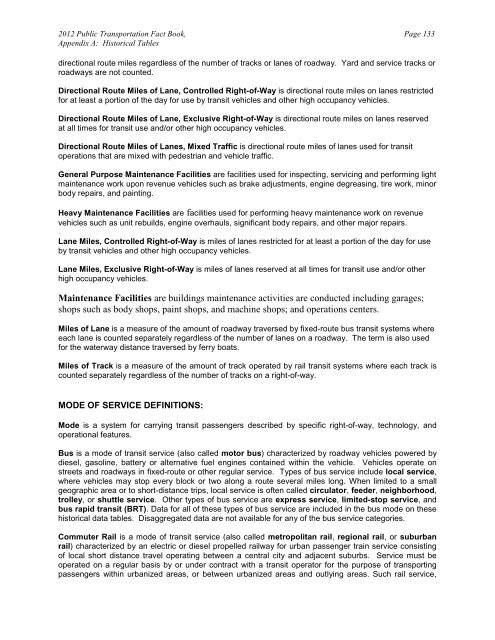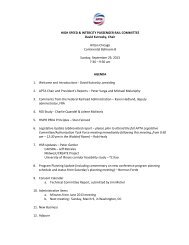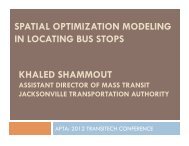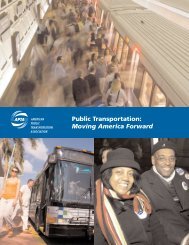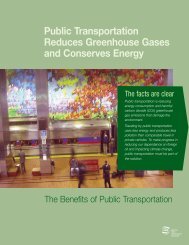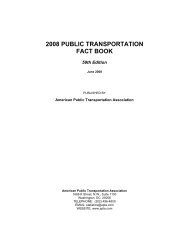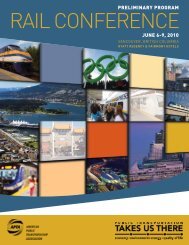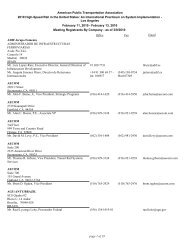2012 APTA Fact Book Appendix A - American Public Transportation ...
2012 APTA Fact Book Appendix A - American Public Transportation ...
2012 APTA Fact Book Appendix A - American Public Transportation ...
Create successful ePaper yourself
Turn your PDF publications into a flip-book with our unique Google optimized e-Paper software.
<strong>2012</strong> <strong>Public</strong> <strong>Transportation</strong> <strong>Fact</strong> <strong>Book</strong>,<br />
<strong>Appendix</strong> A: Historical Tables<br />
Page 133<br />
directional route miles regardless of the number of tracks or lanes of roadway. Yard and service tracks or<br />
roadways are not counted.<br />
Directional Route Miles of Lane, Controlled Right-of-Way is directional route miles on lanes restricted<br />
for at least a portion of the day for use by transit vehicles and other high occupancy vehicles.<br />
Directional Route Miles of Lane, Exclusive Right-of-Way is directional route miles on lanes reserved<br />
at all times for transit use and/or other high occupancy vehicles.<br />
Directional Route Miles of Lanes, Mixed Traffic is directional route miles of lanes used for transit<br />
operations that are mixed with pedestrian and vehicle traffic.<br />
General Purpose Maintenance Facilities are facilities used for inspecting, servicing and performing light<br />
maintenance work upon revenue vehicles such as brake adjustments, engine degreasing, tire work, minor<br />
body repairs, and painting.<br />
Heavy Maintenance Facilities are facilities used for performing heavy maintenance work on revenue<br />
vehicles such as unit rebuilds, engine overhauls, significant body repairs, and other major repairs.<br />
Lane Miles, Controlled Right-of-Way is miles of lanes restricted for at least a portion of the day for use<br />
by transit vehicles and other high occupancy vehicles.<br />
Lane Miles, Exclusive Right-of-Way is miles of lanes reserved at all times for transit use and/or other<br />
high occupancy vehicles.<br />
Maintenance Facilities are buildings maintenance activities are conducted including garages;<br />
shops such as body shops, paint shops, and machine shops; and operations centers.<br />
Miles of Lane is a measure of the amount of roadway traversed by fixed-route bus transit systems where<br />
each lane is counted separately regardless of the number of lanes on a roadway. The term is also used<br />
for the waterway distance traversed by ferry boats.<br />
Miles of Track is a measure of the amount of track operated by rail transit systems where each track is<br />
counted separately regardless of the number of tracks on a right-of-way.<br />
MODE OF SERVICE DEFINITIONS:<br />
Mode is a system for carrying transit passengers described by specific right-of-way, technology, and<br />
operational features.<br />
Bus is a mode of transit service (also called motor bus) characterized by roadway vehicles powered by<br />
diesel, gasoline, battery or alternative fuel engines contained within the vehicle. Vehicles operate on<br />
streets and roadways in fixed-route or other regular service. Types of bus service include local service,<br />
where vehicles may stop every block or two along a route several miles long. When limited to a small<br />
geographic area or to short-distance trips, local service is often called circulator, feeder, neighborhood,<br />
trolley, or shuttle service. Other types of bus service are express service, limited-stop service, and<br />
bus rapid transit (BRT). Data for all of these types of bus service are included in the bus mode on these<br />
historical data tables. Disaggregated data are not available for any of the bus service categories.<br />
Commuter Rail is a mode of transit service (also called metropolitan rail, regional rail, or suburban<br />
rail) characterized by an electric or diesel propelled railway for urban passenger train service consisting<br />
of local short distance travel operating between a central city and adjacent suburbs. Service must be<br />
operated on a regular basis by or under contract with a transit operator for the purpose of transporting<br />
passengers within urbanized areas, or between urbanized areas and outlying areas. Such rail service,


